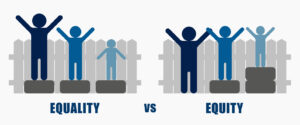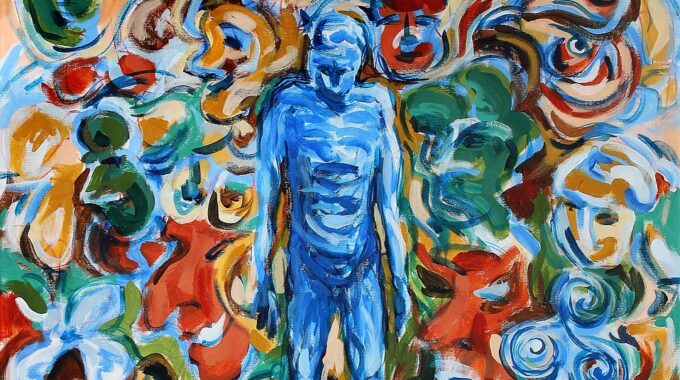Myth: Trickle Down Economics Works Since the days of Ronald Reagan, many have promoted the…

What is DEI?
Diversity, Equity & Inclusion at Work
The business case for diversity was driven by the belief that a more diverse workforce would produce better results and have a positive impact in the marketplace. Having a diverse workforce is important, but companies have realized that you must have a workplace culture that is inclusive. Organizations that have more success with creating a diverse and inclusive culture have linked and integrated it to the organization’s core values, mission and business objectives. Many focus on the importance of having cultural competence as an important skill domestically as well as in the global arena. Achieving diversity and inclusion requires intentional efforts and a strong commitment of senior leadership.
In the 1980s organizations began by working on diversity alone. They made attempts to hire for diversity which in most cases meant people of color. There’s much more to diversity however. There is the diversity we see (skin color, hijab, wheelchair, gray hair) and the diversity we DON’T see (PTSD, mental health, neurodiversity, class).
What is diversity? The presence of differences that make each person unique.
 Think of diversity as an iceberg. Much of what we see as diversity is above the surface but much of what exists is below the surface.
Think of diversity as an iceberg. Much of what we see as diversity is above the surface but much of what exists is below the surface.
Sara Taylor, founder of deepSEE Consulting describes diversity as “differences that may make a difference.”
Diversity is the collection of similarities and differences that we each carry with us is based upon:
- Characteristics we were born with
- Experiences we have had
- Choices we have made.
What is inclusion? The full engagement and development of all employees.
Next in the developmental chronology came inclusion. It was discovered, through trial and error, that diversity wasn’t enough. An organization had to include everyone – and create a sense of belonging or their newfound diverse employees would walk out the door. If you are diverse AND
- Look/feel different than the majority
- Minimize or maximize traits about yourself to “fit in”
- Seek acceptance of your authentic self
- Disengage when you do not feel seen or heard THEN
- You will exit because you do not feel you belong.
Diversity and inclusion is an experience. In the US we’ve been led to believe that we are a great melting pot and that eventually we all become part of the universal soup of our culture. In reality – we are more like a tossed salad. In a tossed salad the individual fruits, nuts or vegetables retain their taste and shape. They exist next to each other. Some of ingredients are permeable and soak in the dressing (croutons) while others treat the dressing as a separate flavor which they will carry forward without changing their own texture and flavor (grapes). Think of your organization as a tossed salad. Inclusion is an experience – and those who do not experience inclusion will leave eventually.
If you’re working to improve your organization, you may pour money into the sales, marketing or product development bucket – although the bucket which can have the most impact ON those other buckets is the employee bucket which holds employee training, salaries, benefits and other aspects that impact employee engagement and a feeling of belonging.
What is equity? An approach to ensure everyone has access to same opportunities.
 Equity came next when organizations and their employees realized that the golden rule no longer fit. Treating others as you wish to be treated does not take into consideration that other people from other backgrounds or cultures don’t necessarily see the world as you do or need the same things that you do. Follow instead the platinum rule and treat others as they themselves wish to be treated.
Equity came next when organizations and their employees realized that the golden rule no longer fit. Treating others as you wish to be treated does not take into consideration that other people from other backgrounds or cultures don’t necessarily see the world as you do or need the same things that you do. Follow instead the platinum rule and treat others as they themselves wish to be treated.
Not everyone needs the same thing. Neurodiverse people may need an office with a door. People of certain religions may need a place to say their daily prayers. Starting pay may need to be a set amount rather than a range because men tend to inflate their worth when being hired and women tend to minimize. The gender wage income gap grows larger each year when it begins in different places. Making an accommodation for one person doesn’t mean it needs to become a company policy.
To reap the fruit of life, some people can stand on their own two feet, some people may need a little stool and a third person may need a ladder or to stand on someone’s back.
Benefits and Risks
 When we have a difficult choice to make we often start with a list of pros and cons. If you were to do that with diversity, equity and inclusion benefits and risks, your list would certainly include these proven benefits:
When we have a difficult choice to make we often start with a list of pros and cons. If you were to do that with diversity, equity and inclusion benefits and risks, your list would certainly include these proven benefits:
- 2x more likely to meet or exceed financial targets
- 3x more likely to be high performing
- 6x more likely to be innovative and agile
- 8x more likely to achieve better business outcomes.
Most of the benefits come with positive financial results. If you were to consider the downside of DEI efforts your list might look like this:
- Those in power may feel uncomfortable. It is hard to acknowledge one’s white male privilege for example.
- Organizations may be change resistant. However, change is part of life.
- DEI assessments and strategies cost money.
- DEI work can expose sexism, homophobia, racism, classism, ableism, antisemitism and ageism.
We hope it is clear to you that the benefits outweigh any potential risk.
Source: University of Michigan, “Defining DEI”
Source: Deloitte, “Diversity and Inclusion Revolution“



